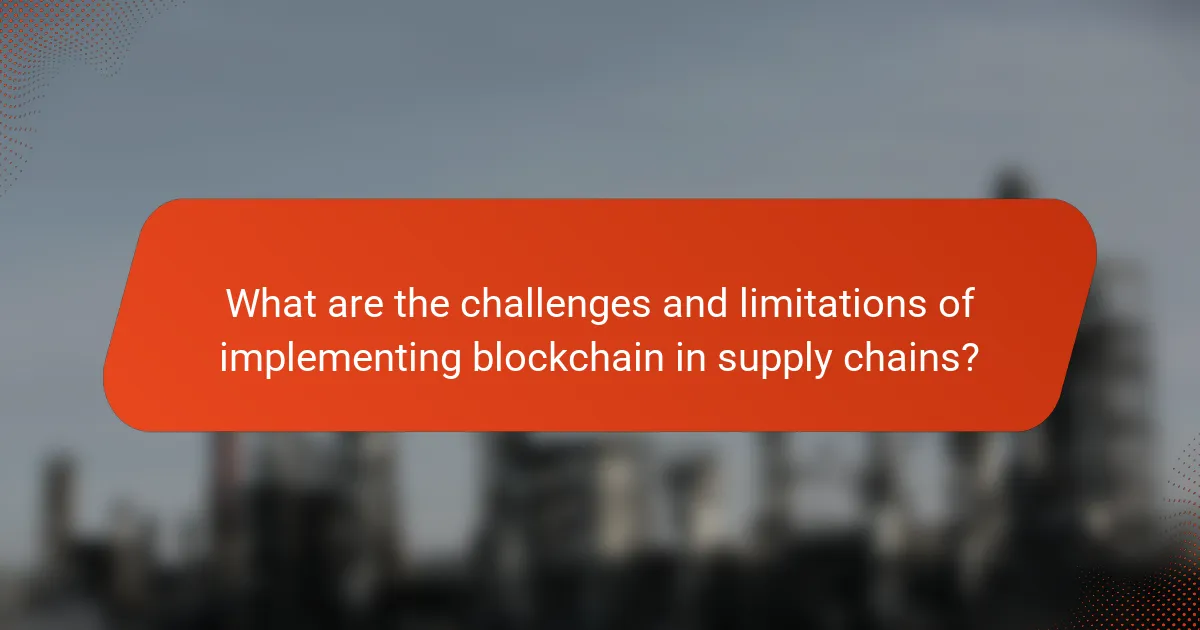Blockchain technology is a decentralized digital ledger that records transactions across multiple computers, ensuring information integrity and enhancing supply chain transparency. By providing real-time access to immutable records, blockchain allows all participants to track products from origin to destination, fostering trust and reducing fraud. While studies indicate significant belief among supply chain executives in blockchain’s potential to improve transparency, challenges such as scalability, integration issues, and regulatory concerns remain. This article explores the role of blockchain in supply chain transparency, highlighting its unique features and the obstacles companies face in its implementation.

What is Blockchain Technology and Its Role in Supply Chain Transparency?
Blockchain technology is a decentralized digital ledger that records transactions across multiple computers. It ensures that the recorded information cannot be altered retroactively without the consensus of the network. This feature enhances supply chain transparency by allowing all parties to access the same information in real-time. Each transaction is time-stamped and linked to previous transactions, creating an immutable record. This traceability helps in identifying the origin of products and tracking their movement through the supply chain. A study by Deloitte found that 40% of supply chain executives believe blockchain can enhance transparency. By using blockchain, companies can reduce fraud and errors while improving trust among stakeholders.
How does blockchain technology function within supply chains?
Blockchain technology functions by providing a decentralized and immutable ledger for transactions within supply chains. This technology enables real-time tracking of products from origin to destination. Each transaction is recorded in a block and linked to previous transactions, ensuring transparency and traceability. Participants in the supply chain can access the same information simultaneously. This reduces fraud and errors by providing a single source of truth. Smart contracts can automate processes, enhancing efficiency. According to a study by IBM, 70% of supply chain professionals believe blockchain will significantly impact their operations.
What are the key components of blockchain technology?
The key components of blockchain technology are distributed ledger, consensus mechanism, cryptography, and smart contracts. A distributed ledger is a decentralized database that records all transactions across a network. This ensures transparency and security in data management. The consensus mechanism validates transactions and maintains the integrity of the blockchain. Common types include Proof of Work and Proof of Stake. Cryptography secures data through encryption, protecting sensitive information from unauthorized access. Smart contracts are self-executing contracts with the terms directly written into code, automating processes and reducing the need for intermediaries. These components collectively contribute to the efficiency and reliability of blockchain technology.
How do these components enhance supply chain operations?
Blockchain technology enhances supply chain operations by improving transparency, traceability, and efficiency. It allows all parties to access a single, immutable ledger of transactions. This transparency reduces fraud and errors in the supply chain. Traceability enables companies to track products from origin to destination. This capability is crucial for compliance with regulations and standards. Additionally, smart contracts automate processes and reduce the need for intermediaries. This streamlines operations and cuts costs. According to a 2020 study by the World Economic Forum, blockchain can reduce supply chain costs by up to 20%.
Why is supply chain transparency important?
Supply chain transparency is important because it enhances accountability and trust among stakeholders. It allows companies to track the origin of materials and monitor compliance with regulations. This visibility can lead to improved efficiency and reduced risks in operations. According to a study by the World Economic Forum, 70% of supply chain executives believe transparency will improve their operations. Additionally, transparency can help identify inefficiencies and reduce costs. It also fosters consumer trust, as customers increasingly demand to know the source of products. In today’s market, companies with transparent supply chains often have a competitive advantage.
What are the benefits of transparency in supply chains?
Transparency in supply chains enhances accountability and builds trust among stakeholders. It allows consumers to verify product origins and ensures ethical sourcing. Companies can identify inefficiencies and reduce costs through visibility. Improved transparency can lead to better compliance with regulations. Research shows that 66% of consumers are willing to pay more for sustainable brands. Transparency can also enhance brand loyalty and customer satisfaction. Overall, it fosters collaboration and strengthens relationships across the supply chain.
How does transparency impact consumer trust?
Transparency significantly enhances consumer trust. When companies openly share information about their practices, consumers feel more secure in their purchasing decisions. A study by Label Insight found that 94% of consumers are more likely to be loyal to a brand that offers complete transparency. Transparency reduces uncertainty and fosters a sense of accountability. Consumers are more inclined to trust brands that disclose product sourcing, manufacturing processes, and ingredient lists. This trust translates into increased customer loyalty and positive brand reputation. Ultimately, transparency serves as a foundation for building long-lasting relationships between consumers and brands.

What are the unique features of blockchain that promote transparency in supply chains?
Blockchain technology promotes transparency in supply chains through its decentralized, immutable, and transparent nature. Decentralization means that no single entity controls the entire network. This reduces the risk of data manipulation and fosters trust among participants. Immutability ensures that once data is recorded, it cannot be altered or deleted. This feature guarantees the integrity of information across the supply chain. Transparency allows all participants to access the same data in real-time. This visibility helps in tracking products from origin to destination. A study by Accenture found that 83% of supply chain executives believe blockchain will enhance transparency. These unique features collectively enhance accountability and traceability in supply chains.
How does decentralization contribute to supply chain transparency?
Decentralization enhances supply chain transparency by distributing control across multiple stakeholders. This structure reduces the risk of data manipulation. Each participant in the supply chain can access and verify information independently. Blockchain technology exemplifies this by providing a secure, immutable ledger. Transactions recorded on a blockchain are visible to all authorized parties. This visibility fosters trust among stakeholders. A 2020 study by the World Economic Forum noted that transparency can reduce fraud by up to 50%. Thus, decentralization leads to a more accountable and trustworthy supply chain.
What specific advantages does decentralization provide?
Decentralization provides enhanced security, transparency, and resilience in systems. It reduces the risk of single points of failure. In a decentralized network, data is distributed across multiple nodes. This distribution makes unauthorized access and data tampering more difficult. Transparency is improved as all transactions are recorded on a public ledger. Each participant can verify transactions independently, fostering trust. Additionally, decentralization can lead to increased efficiency. It eliminates the need for intermediaries, streamlining processes. According to a study by the World Economic Forum, decentralized systems can reduce transaction costs by up to 40%.
How does decentralization affect data integrity?
Decentralization enhances data integrity by distributing data across multiple nodes. This reduces the risk of data manipulation. Each node maintains a copy of the data, ensuring consistency. In a decentralized system, altering data requires consensus from multiple parties. This makes unauthorized changes more difficult. Research shows that decentralized systems like blockchain provide tamper-proof records. For instance, a study by Nakamoto (2008) highlights how Bitcoin’s blockchain ensures transaction integrity through its consensus mechanism. Thus, decentralization significantly strengthens data integrity by leveraging distributed consensus and redundancy.
What role does immutability play in enhancing supply chain transparency?
Immutability plays a crucial role in enhancing supply chain transparency by ensuring that once data is recorded, it cannot be altered or deleted. This characteristic of blockchain technology fosters trust among supply chain participants. Each transaction is time-stamped and linked to previous transactions, creating a permanent and verifiable record. This transparency allows stakeholders to trace the origin and journey of products. According to a study by Accenture, 83% of supply chain executives believe that blockchain’s immutability can significantly improve supply chain visibility. Furthermore, immutability helps in reducing fraud and errors, as any discrepancies can be easily identified and addressed. This results in a more reliable and efficient supply chain system.
How does immutability ensure data accuracy?
Immutability ensures data accuracy by preventing unauthorized alterations to stored information. In blockchain technology, once a transaction is recorded, it cannot be changed or deleted. This feature is achieved through cryptographic hashing. Each block contains a unique hash of the previous block, creating a secure chain. If any data within a block is altered, the hash changes, breaking the chain. This alerts users to potential tampering. Additionally, decentralized consensus mechanisms verify transactions before they are added to the blockchain. This multi-party validation enhances trust in the accuracy of the data recorded.
What are the implications of immutability for supply chain stakeholders?
Immutability in blockchain technology ensures that once data is recorded, it cannot be altered or deleted. This characteristic significantly impacts supply chain stakeholders by enhancing data integrity and trust. Stakeholders can rely on accurate and consistent information throughout the supply chain. For example, immutable records prevent fraud and errors in transaction data. This leads to improved accountability among parties, as every transaction is verifiable. Additionally, immutability facilitates compliance with regulations, as stakeholders can provide unalterable proof of their processes. Overall, immutability fosters transparency and efficiency in supply chain operations, ultimately benefiting all stakeholders involved.

What are the challenges and limitations of implementing blockchain in supply chains?
The challenges and limitations of implementing blockchain in supply chains include scalability, integration issues, and regulatory concerns. Scalability is a significant challenge as blockchain networks can struggle to handle a high volume of transactions efficiently. Integration with existing systems is often complex and resource-intensive, requiring substantial changes in infrastructure. Regulatory concerns arise due to the lack of clear legal frameworks governing blockchain use. Data privacy issues also present limitations, as sensitive information may be exposed on public blockchains. Additionally, the technology’s immaturity can lead to uncertainty in long-term viability. Security vulnerabilities, while generally lower than traditional systems, still pose risks, especially in smart contracts.
What obstacles do companies face when adopting blockchain technology?
Companies face several obstacles when adopting blockchain technology. High initial costs for implementation can deter investment. Integration with existing systems poses significant challenges. Lack of skilled workforce limits effective deployment. Regulatory uncertainty creates hesitation among businesses. Data privacy concerns may inhibit information sharing. Scalability issues can affect transaction speed and efficiency. Limited understanding of blockchain’s potential leads to underutilization. These factors collectively hinder widespread adoption in various industries.
How can resistance to change affect blockchain implementation?
Resistance to change can significantly hinder blockchain implementation. Organizations may face pushback from employees who are accustomed to traditional processes. This resistance can lead to delays in adopting blockchain technology. A study by McKinsey found that 70% of change initiatives fail due to employee resistance. When stakeholders do not embrace the new technology, it can result in incomplete integration. Lack of training and understanding can exacerbate this issue. Consequently, the potential benefits of blockchain, such as enhanced transparency and efficiency, may not be realized. Overall, effective change management strategies are essential for successful blockchain adoption.
What are the technical challenges associated with blockchain integration?
Technical challenges associated with blockchain integration include scalability, interoperability, and security. Scalability refers to the ability of a blockchain network to handle an increasing number of transactions. Many blockchain systems struggle with transaction speed and throughput, limiting their use in high-volume applications. Interoperability involves the ability of different blockchain networks to communicate and work together. Many existing blockchains operate in silos, making it difficult to share data across platforms. Security is a critical concern as blockchain systems can be vulnerable to attacks, especially if smart contracts are poorly coded. Additionally, the complexity of integrating blockchain with existing systems can lead to implementation challenges. These factors contribute to the hesitation of organizations in adopting blockchain technology fully.
How can companies overcome these challenges?
Companies can overcome challenges in blockchain technology by investing in training and education. This ensures employees understand the technology and its applications. Collaborating with technology providers can simplify integration into existing systems. Establishing clear governance frameworks enhances accountability and transparency. Engaging stakeholders fosters trust and encourages participation in the blockchain system.
Adopting standardized protocols ensures interoperability between different blockchain platforms. Conducting pilot projects allows companies to test solutions before full implementation. Regularly evaluating and updating strategies helps adapt to evolving challenges. These approaches collectively strengthen the effectiveness of blockchain in enhancing supply chain transparency.
What best practices should companies follow for successful implementation?
Companies should follow best practices such as defining clear objectives for blockchain implementation. Establishing measurable goals ensures alignment with business needs. Engaging stakeholders early fosters buy-in and collaboration. Training employees on blockchain technology enhances understanding and adoption. Selecting the right technology partners is crucial for successful integration. Conducting pilot projects helps identify challenges before full-scale deployment. Regularly reviewing and updating processes maintains efficiency and relevance. These practices contribute to the overall success of blockchain initiatives in supply chain transparency.
How can collaboration among stakeholders facilitate smoother adoption?
Collaboration among stakeholders can facilitate smoother adoption of blockchain technology in supply chains. It fosters shared understanding and alignment on goals. When stakeholders communicate effectively, they can address concerns and resistance early. Collaborative efforts also enable pooling of resources for training and implementation. This reduces the burden on individual entities and enhances overall readiness. Moreover, joint problem-solving leads to innovative solutions tailored to specific supply chain needs. Successful case studies, such as IBM Food Trust, demonstrate that collaboration accelerates trust and transparency. These factors are crucial for widespread acceptance and integration of blockchain solutions.
What are the future trends of blockchain technology in supply chain transparency?
Future trends of blockchain technology in supply chain transparency include increased adoption of decentralized systems. These systems enhance data integrity and traceability. More companies will utilize smart contracts for automated compliance and transaction execution. Enhanced interoperability between different blockchain platforms will emerge. This will facilitate seamless data sharing among stakeholders. The integration of IoT devices with blockchain will provide real-time tracking of goods. Additionally, regulatory frameworks will evolve to support blockchain implementations. Studies indicate that transparency can reduce fraud and improve efficiency in supply chains. According to a report by Deloitte, 40% of companies plan to invest in blockchain for supply chain management by 2025.
How will advancements in blockchain technology shape supply chains?
Advancements in blockchain technology will significantly enhance supply chains by improving transparency and traceability. Blockchain allows for real-time tracking of products from origin to destination. This technology ensures that all transactions are recorded in an immutable ledger. As a result, stakeholders can verify the authenticity of goods. Increased transparency reduces fraud and counterfeiting risks. According to a study by the World Economic Forum, blockchain can reduce supply chain costs by up to 20%. Enhanced data sharing among participants leads to better decision-making. Overall, blockchain technology is poised to revolutionize supply chain management.
What innovations are expected to enhance transparency further?
Innovations expected to enhance transparency further include advanced blockchain protocols and smart contracts. These technologies enable real-time tracking of goods and services throughout the supply chain. Enhanced data sharing mechanisms will allow stakeholders to access verified information promptly. Additionally, integration of IoT devices can provide continuous monitoring of products. Artificial intelligence can analyze data for anomalies, increasing accountability. These innovations collectively improve traceability and trust among supply chain participants. Research by Deloitte highlights that 79% of organizations see blockchain as a key to improving transparency in supply chains.
What practical steps can organizations take to leverage blockchain for supply chain transparency?
Organizations can implement blockchain for supply chain transparency by following several practical steps. First, they should identify key supply chain processes that would benefit from transparency. This includes tracking the provenance of goods and verifying certifications. Next, organizations must select an appropriate blockchain platform that aligns with their needs. They should consider factors such as scalability, security, and interoperability.
After selecting a platform, organizations need to establish partnerships with suppliers and stakeholders to ensure data sharing and collaboration. Implementing smart contracts can automate processes and enforce compliance among parties. Additionally, organizations should invest in training their workforce on blockchain technology to enhance understanding and adoption.
Finally, they must continuously monitor and evaluate the blockchain system for effectiveness and make necessary adjustments. According to a report by Deloitte, 40% of surveyed supply chain executives believe that blockchain will be a critical component of their supply chain strategy within the next two years. This highlights the growing recognition of blockchain’s potential in enhancing transparency.
Blockchain technology serves as a decentralized digital ledger that enhances supply chain transparency by providing immutable, real-time access to transaction data. This article explores the key components of blockchain, including its distributed ledger, consensus mechanisms, and smart contracts, and how they improve traceability and accountability among supply chain stakeholders. It also addresses the importance of transparency for consumer trust and the challenges companies face in implementing blockchain solutions. Additionally, future trends and practical steps for leveraging blockchain in supply chains are discussed, highlighting its potential to revolutionize supply chain management.




